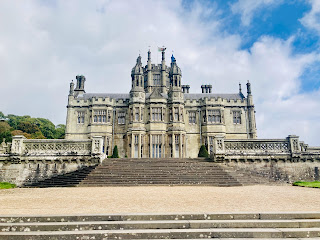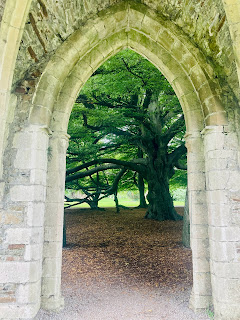Margam Gardens
Margam gardens and castle
 |
| Margam castle |
After the Norman Invasion of Wales in the 11th century, Robert Consul (d. 1147), 1st Earl of Gloucester the illegitimate son of King Henry I of England, and Lord of Glamorgan, granted the lands at Margam to Clairvaux Abbey, a French order of white-robed Catholic monks founded by St. Bernard, for the establishment of a new Cistercian monastery which became Margam Abbey. Earl Robert’s bequest comprised ‘all the land between the Kenfig and Afan rivers, from the brow of the mountains to the sea’.
 |
| Abbey ruins |
Once the largest and richest monastery in Wales, the Abbey remained an important center of significance until its dissolution at the hands of Henry VIII in the 1530s. Part of the medieval Abbey survives as St Mary's parish church, and beside the church is the Margam Stone Museum, with pre-Norman and medieval carved stones from the area.
 |
| Orangery |
Margam Castle is a 19th-century Tudor Gothic Mansion built on an 850-acre country estate in 1830–35 by Christopher Rice Mansel Talbot. He hired Thomas Hopper as his architect, with instructions to create a Tudor Gothic fantasy using softer ashlar sandstone from the nearby Pyle quarry and harder stone used internally for the grand staircase and hall. Hopper was encouraged to let his imagination run free, and the result is a Victorian fantasy, a myriad of turrets, towers, battlements and cupolas, gables, and pinnacles mixed and matched with abandon, and centered around three courtyards.
The house and estate remained in the ownership of the Talbot family until 1942, the end of the second world war, and the ensuing quarter of a century of neglect took its toll and the building was in a badly deteriorated condition when acquired by the present owners.
The house was extensively damaged by fire in 1977, restoration work has been undertaken and parts of the house are in use. The Gothic features of the Castle have been the setting for many film and tv productions including Dr Who and Da Vinci's Demons.
References
2. Palmer, C., 2008. Margam Park - Port Talbot. [online] Parks & Gardens. Available at: <https://www.parksandgardens.org/places/margam-park> [Accessed 26 September 2022].





Comments
Post a Comment
Please keep conversations courteous and on-topic. Kindly don’t engage in trolling, flame-baiting, name-calling, insulting, stereotyping or gratuitous attacks. Thank you for being a good citizen.